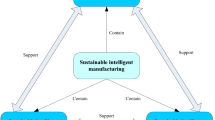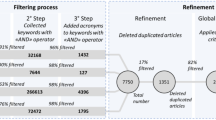Abstract
Jigs and fixtures are one of the important aspects of manufacturing. Parts may have different sets of fixturing requirements and call for different design strategies. Although there are numerous possibilities for fixture designs, a few basic configurations are clearly identifiable. Computer aided design (CAD) has done a little in assisting designers to design jigs and fixtures, making decisions of the best design selection, and providing designers with suggestions. The goal of this paper is to develop and document the design parameters and specifications utilized in jigs and fixtures design using universal modular jigs and fixtures design system (UMJFS). This is the first step to develop a knowledge-based Jigs and Fixture design and selection system. This application has the advantages of making the fixture design information completely modular and transparent, providing better match to the working conditions, reducing lead-time, and generally providing a significant enhancement of fixture productivity and economy. UMJFS has different standard and modular elements. This makes jigs and fixtures elements interchangeable and reusable. Designing a UMJFS then becomes a task of selecting and assembling the proper elements together.
Similar content being viewed by others
References
Abou-Hanna, J., Okamura, K. and McGreevy, T. (1993) Sinkage characteristics of workpieces in flexible particulate bed fixtures: An experimental and numerical investigation. Journal of Manufacturing Systems, 13(5), 359–369.
Abou-Hanna, J. Okamura, K. and McGreevy, T. (1993) Experimental study of static and dynamic rigidities of flexible particulate bed fixtures under external vertical and torque loads. Journal of Manufacturing Systems, 13(3), 177–189.
Amirouche, F. M. L. (1993) Computer-Aided Design and Manufacturing, Prentice Hall Inc.
Arora J. S. (1989) Introduction to Optimum Design, McGraw Hill Inc.
Balachandran, M. (1993) Knowledge-based Optimum Design, Hobbs the Printers Ltd, Southampton.
Bardasz T. (1991) Mechanical design automation via case-based reasoning: An incremental intelligent approach. M.S. Thesis, Department of Mechanical Engineering, Northeastern University, MA.
Bardasz, T. (1991) Mechanical design automation via case-based reasoning: An incrementally intelligent approach, M.S. Thesis, Northeastern University.
Ceglarek, D. J. and Shi, J. (1994) Fixture failure diagnosis for autobody assembly using pattern recognition. Manufacturing Science and Engineering, 1, 263–275, (ASME).
Chou, Y.-C. (1994) Geometric reasoning for layout design of machining fixtures. The International Journal of Computer Integrated Manufacturing, 7(3), 175–185.
Chou, Y.-C., Srinivas, R. A. and Sarafs., (1994) Automatic design of machining fixtures: conceptual design. The International Journal of Advanced Manufacturing Technology, 9, 3–12.
Colvin, F. H. and Stanley, F. A. (1948) Jigs and Fixtures, First Edition, McGraw Hill Book Company Inc.
Daube, F. and Hayes-Roth, B. (1990) A case-based mechanical redesign system, AAAI Proceedings, pp. 1402–1407.
DeMeter, E. C. (1994) Restraint analysis of fixtures which rely on surface contact. Journal of Engineering for Industry, 116, 207–215.
Englert, P. J. and Wright, P. K. (1986) Sharpening the senses of industrial robots. Mechanical Engineering, 108, 58–63.
Hallum, D. L. (1995) Tool changes in a jiffy. American Machinist, 41–44.
Hammond, K. (ed.) (1989) Case-Based Reasoning Workshop, Proceedings, San Matteo, CA, Morgan Kauffman.
Hanada, T., Bandyopadhyay, B.P. and Hoshi, T. (1994) Implementation of low-volume FMS for prismatic components. Journal of Manufacturing Systems, 14(2), 91–108.
Hargrove, S. K. (1994) Characteristics of job shop operations in fixture design. Industrial Engineering.
Hockenberger, M. J. and De Meter, E. C. (1995) The effect of machining fixture design parameters on workpiece displacement. Manufacturing Review, 8(1), 22–32.
Hoffman E. G. (1962) Fundamentals of Tool Design, Prentice Hill Inc.
Kalay Y. E. (1987) Computability of Design, John Wiley and Sons Inc.
Kempster, M. H. (1969) Principles of Jigs and Tool Design, Hart Publishing Company Inc.
King, L.S.-B. (1994) Theoretical approach for generating optimal fixturing locations for prismatic workparts in automated assembly. Journal of Manufacturing systems, 12(5), 409–416.
Kolonder, J. L. (ed.) (1988) Case-Based Reasoning Workshop, Proceedings, San Matteo, CA, Morgan Kauffman.
Liu, C.-L. (1994) A systematic conceptual design of modular fixtures. The International Journal of Advanced Manufacturing Technology, 9, 217–224.
Mason, F. (1995) Computer-aided fixture design. Manufacturing Engineering, 41–45.
Miller, P. C. (1994) Workholding for CNC efficiency-part I. Tooling and Production, 29–45.
Navinchandra, D. (1989) Case-based reasoning in CYCLOPS, design problem solver, Proceedings of the Case-Based Reasoning Workshop, San Matteo, CA, Morgan Kauffman, pp. 286–301.
Ohashi, K. (1994) An integration approach to process design and parts-layout planning. The International Journal of Production Economics, 33, 237–245.
Pham, D. T. (1991) Artificial Intelligence in Design, Springer-Verlag London Limited, U.K.
Pham, M. J. N. and Lazaro, A. de Sam (1989) A knowledge-based jig-and-fixture assistant. The International Journal of Advanced Manufacturing Technology, 4, 26–45.
Rong, Y. Wu, S.-h. and Chu, T. P. (1994) Automated verification of clamping stability in computer-aided fixture design. Computers in Engineering, 1, 421–426.
Roy, U. and Sun, P.-L. (1994) Selection of preliminary location and clamping positions on a workpiece for an automatic fixture design system. Computer Integrated Manufacturing Systems, 7(3), 161–172.
Sayeed, Q. A. and DeMeter, E. C. (1994) Machining fixture design and analysis software. International Journal of Production Research, 32(7), 1655–1674.
Sriram, D. and Adey, R. (1986) Applications of artificial intelligence in engineering problems, Springer-Verlag Berlin, Heidelberg.
Willy, A., Sadler, J. P. and Schraft, R. D. (1995) Automated fixture design. The International Journal of Advanced Manufacturing Technology, 10, 27–35.
Yashima, M. and Kimurai, H. (1994) Intelligent jig with function of manipulation. Transactions of the Japan Society of Mechanical Engineers, 60, 51–57.
Yetal X. (1983) A modular fixuring system(MFS) for flexible manufacturing systems. FMS Magazine, 292–296.
Yoshikawa, H. and Gossard, D. (1989) Intelligent CAD, I, Elsevier Science Publishing Company Inc.
Zhang, Q., Greenway, R. B. and Faddis, T. N. (1994) Development of a 2-D fixturing planning for prismatic parts for a flexible system. Computers in Engineering, 1, 427–435.
Author information
Authors and Affiliations
Rights and permissions
About this article
Cite this article
Kakish, J., Zhang, PL. & Zeid, I. Towards the design and development of a knowledge-based universal modular jigs and fixtures system. Journal of Intelligent Manufacturing 11, 381–401 (2000). https://doi.org/10.1023/A:1008978319436
Issue Date:
DOI: https://doi.org/10.1023/A:1008978319436




